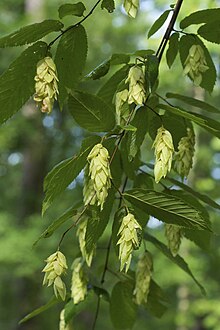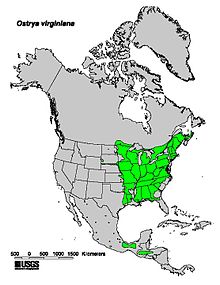| American hophornbeam | |
|---|---|

| |
| A hophornbeam branch with the characteristic hop-resembling fruits in early summer | |
| Conservation status | |
 Least Concern (IUCN 3.1) | |
| Scientific classification | |
| Kingdom: | Plantae |
| Clade: | Tracheophytes |
| Clade: | Angiosperms |
| Clade: | Eudicots |
| Clade: | Rosids |
| Order: | Fagales |
| Family: | Betulaceae |
| Genus: | Ostrya |
| Species: | O. virginiana |
| Binomial name | |
| Ostrya virginiana (Mill.) K.Koch | |

| |
| Generalized native range | |
| Synonyms | |
| |
Ostrya virginiana, the American hophornbeam, is a species of Ostrya native to eastern North America, from Nova Scotia west to southern Manitoba and eastern Wyoming, southeast to northern Florida and southwest to eastern Texas. Populations from Mexico and Central America are also regarded as the same species, although some authors prefer to separate them as a distinct species, Ostrya guatemalensis. Other names include eastern hophornbeam, hardhack (in New England), ironwood, and leverwood.
Description
Ostrya virginiana (American hophornbeam) is a small deciduous understory tree growing to 18 m (59 ft) tall and 20–50 centimetres (8–20 in) trunk diameter. The bark is brown to gray-brown, with narrow shaggy plates flaking off, while younger twigs and branches are smoother and gray, with small lenticels. Very young twigs are sparsely fuzzy to thickly hairy; the hairs (trichomes) drop off by the next year.
The leaves are ovoid-acute, 5–13 cm (2–5 in) long and 4–6 cm (1+1⁄2–2+1⁄4 in) broad, pinnately veined, with a doubly serrated margin. The upper surface is mostly hairless, while the lower surface is sparsely to moderately fuzzy (rarely densely hairy).
The flowers are catkins (spikes) produced in early spring at the same time as the new leaves appear. The staminate (male) catkins are 2–5 cm (3⁄4–2 in) long, and arranged in groups of 1–4. The pistillate (female) catkins are 8–15 mm (5⁄16–19⁄32 in) long, containing 10–30 flowers each.
Pollinated female flowers develop into small nutlets 3–5 mm (1⁄8–3⁄16 in) long fully enclosed in a papery sac-shaped involucre 10–18 mm (3⁄8–11⁄16 in) long and 8–10 mm (5⁄16–3⁄8 in) wide. The involucre changes from greenish-white to dull brown as the fruit matures.
American hophornbeam is similar to its close relative American hornbeam (Carpinus caroliniana), which can be distinguished by its smooth bark and nutlets enclosed in open, three-lobed bracts.
-
 Bark of a mature tree
Bark of a mature tree
-
 Male catkins hanging from the branches in spring (United States Botanic Garden)
Male catkins hanging from the branches in spring (United States Botanic Garden)
-
 Leaf color in autumn
Leaf color in autumn
-
 Two trees in winter with some dried leaves still hanging on their branches (marcescence)
Two trees in winter with some dried leaves still hanging on their branches (marcescence)
-
 An exceptionally large trunk
An exceptionally large trunk
Subdivisions
There are two subspecies:
- Ostrya virginiana subsp. guatemalensis (H.J.P.Winkl.) A.E.Murray – central and southern Mexico, Guatemala, Honduras, El Salvador
- Ostrya virginiana subsp. virginiana – eastern half of United States, eastern Canada
Populations along the Atlantic coast have slightly smaller leaves, and are sometimes separated as O. virginiana var. lasia Fernald.
Habitat and ecology
In temperate areas of the US and Canada, Ostrya virginiana is found in lowland and foothill forests, where it is predominantly an understory tree.
In Mexico and Central America, Ostrya virginiana is found in cloud forests and humid portions of mid-elevation oak, pine–oak, and pine forests between 1200 and 2800 meters elevation.
The buds and catkins are important source of winter food for some birds, notably ruffed grouse (Bonasa umbellus). Additionally, the nutlets and buds are eaten by birds, deer, and rabbits.
Uses
It is not typically grown as an ornamental plant and is sometimes used as a street tree.
Its wood is very resilient and is valued for making tool handles and fence posts.
Being a diffuse porous hardwood and having extremely high density and resistance to compression, it is an excellent material for the construction of wooden longbows.
References
- ^ Little, Elbert L. (1980). The Audubon Society Field Guide to North American Trees: Eastern Region. New York: Knopf. p. 374. ISBN 0-394-50760-6.
- ^ Stritch, L.; Shaw, K.; Roy , S.; Wilson, B. (2014). "Ostrya virginiana". IUCN Red List of Threatened Species. 2014: e.T194540A2346581. doi:10.2305/IUCN.UK.2014-3.RLTS.T194540A2346581.en. Retrieved 19 November 2021.
- ^ ‹ The template below (WCSP) is being considered for deletion. See templates for discussion to help reach a consensus. ›
"Ostrya virginiana". World Checklist of Selected Plant Families (WCSP). Royal Botanic Gardens, Kew.
- "Ostrya virginiana". County-level distribution map from the North American Plant Atlas (NAPA). Biota of North America Program (BONAP). 2014.
- ^ Furlow, John J. (1997). "Ostrya virginiana". In Flora of North America Editorial Committee (ed.). Flora of North America North of Mexico (FNA). Vol. 3. New York and Oxford: Oxford University Press – via eFloras.org, Missouri Botanical Garden, St. Louis, MO & Harvard University Herbaria, Cambridge, MA.
- Nelson Sutherland, C.H. (2008). Catálogo de las plantes vasculares de Honduras. Espermatofitas: 1-1576. SERNA/Guaymuras, Tegucigalpa, Honduras.
- ^ Hilty, John (2020). "Hop Hornbeam (Ostrya virginiana)". Illinois Wildflowers.
- Chayka, Katy; Dziuk, Peter (2016). "Ostrya virginiana (Ironwood)". Minnesota Wildflowers.
- Whittemore, Alan. "Ostrya virginiana". Flora Mesoamericana. Missouri Botanical Garden – via Tropicos.org.
- Mario González-Espinosa, Jorge A. Meave, Francisco G. Lorea-Hernández, Guillermo Ibarra-Manríquez and Adrian C. Newton, eds (2011). The Red List of Mexican Cloud Forest Trees. Fauna & Flora International, Cambridge, UK. 2011. ISBN 9781903703281
- "Ostrya virginiana (Mill". www.srs.fs.usda.gov. Retrieved 2024-03-10.
- "Ostrya virginiana (American Hop-hornbeam, Eastern Hop Hornbeam, Hop Hornbeam, Hop Horn Beam, Ironwood, Leverwood, Wooly Hop hornbeam) | North Carolina Extension Gardener Plant Toolbox". plants.ces.ncsu.edu. Retrieved 2024-03-10.
- Metzger, F. T. (1990). "Ostrya virginiana". In Burns, Russell M.; Honkala, Barbara H. (eds.). Hardwoods. Silvics of North America. Vol. 2. Washington, D.C.: United States Forest Service (USFS), United States Department of Agriculture (USDA) – via Southern Research Station.
External links
- Bioimages: Ostrya virginiana.
- University of Wisconsin – Green Bay. Trees of Wisconsin. Ostrya virginiana. Archived 2009-01-14 at the Wayback Machine
- Virginia Tech Dendrology. Ostrya virginiana Fact Sheet.
- University of Connecticut. Plants Database. Ostrya virginiana.
- Trees, Shrubs, and Woody Vines of North Carolina. Hophornbeam (Ostrya virginiana).
- Yale University. Cyber Flora. Ostrya virginiana.
| Taxon identifiers | |
|---|---|
| Ostrya virginiana |
|
| Carpinus virginiana | |
- IUCN Red List least concern species
- Ostrya
- Hardwood forest plants
- Trees of the Eastern United States
- Flora of the Appalachian Mountains
- Trees of Central America
- Trees of humid continental climate
- Plants described in 1768
- Trees of Northern America
- Flora of the Sierra Madre Occidental
- Flora of the Sierra Madre Oriental
- Cloud forest flora of Mexico